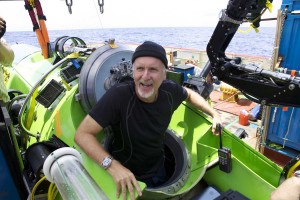
The submersible was launched into the Pacific Ocean some 200 miles southwest of Guam on Monday, March 26, at 5:15 a.m., local Guam time. The voyage down to the Challenger Deep took two hours and 36 minutes. Cameron resurfaced at 12 noon local Guam time on March 26. The submersible — the result of more than seven years of engineering — stayed on the bottom for about three hours as Cameron collected samples for research in marine biology, microbiology, astrobiology, marine geology and geophysics. Cameron also captured still photographs and moving images to visually document the Mariana Trench.
“This journey is the culmination of more than seven years of planning for me and the amazing Deepsea Challenge expedition team,” said Cameron. “Most importantly, though, is the significance of pushing the boundaries of where humans can go, what they can see and how they can interpret it. Without the support of National Geographic and Rolex, and their unwavering belief that we could successfully make it to the deepest point in the ocean — and back — this would not have happened.”
With breakthroughs in materials and science, unique approaches to structural engineering and new ways of imaging through an ultra-small, full ocean depth-rated stereoscopic camera, Cameron was able to launch the Deepsea Challenge expedition, which he hopes will shed light on other virtually unknown deep-water habitats, such as the New Britain Trench and the Sirena Deep.
Cameron’s CAMERON | PACE Group, which supplies 3D technologies /and production support services, provided the capability to document the dive in high-resolution 3D.
The Deepsea Challenge expedition is being chronicled for a 3D feature film for theatrical release on the intensive technological and scientific efforts behind this historic dive — which will subsequently be broadcast on the National Geographic Channel — and is being documented for National Geographic magazine. Cameron also will collaborate with National Geographic to create broad-based educational outreach materials.
Two of Cameron’s passions — filmmaking and diving — blend in his feature and documentary films. While working on Titanic, he took 12 submersible dives to the famed shipwreck two-and-a-half miles down in the North Atlantic. The technical success of that expedition led Cameron to form Earthship Productions, which develops films about ocean exploration and conservation. Since then he has led six expeditions, authored a forensic study of the Bismarck wreck site and done extensive 3D imaging of deep hydrothermal vent sites along the Mid-Atlantic Ridge, the East Pacific Rise and the Sea of Cortez. Cameron has made more than 70 deep submersible dives, including a total of 33 to Titanic. Fifty-one of these dives were in Russian Mir submersibles to depths of up to 3.03 miles (4.87 km).
“We join the rest of the world in celebrating the exhilarating achievement of Jim Cameron and the DEEPSEA CHALLENGE expedition team,” said Terry Garcia, National Geographic’s executive vice president of Mission Programs. “In 2012 we are still exploring largely unknown places — as National Geographic has been doing for nearly 125 years. I’m delighted to say that the golden age of exploration and discovery continues.”
The Challenger Deep has only been reached once before in a manned descent, on Jan. 23, 1960, by U.S. Navy Lt. Don Walsh — who is a consultant on the Deepsea Challenge expedition and was aboard the expedition ship Mermaid Sapphire during Cameron’s successful attempt — and Swiss oceanographer Jacques Piccard in the bathyscaphe Trieste. Walsh and Piccard spent about 20 minutes on the ocean floor before returning to the surface.





